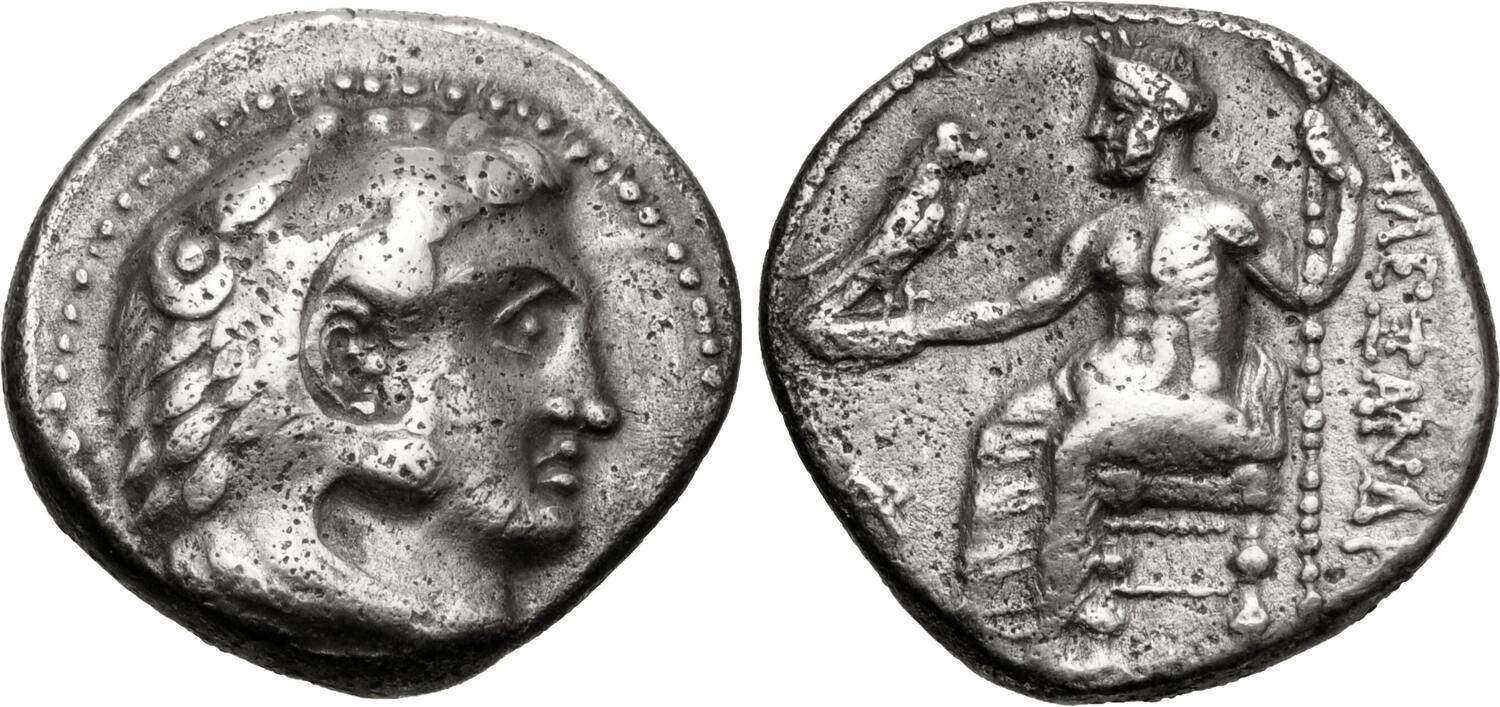S 31 - Aradus (Alexander the Great), silver, drachms (324/3-320 BCE)
From SILVER
324 BCE - 320 BCE Silver 5,432 kg
Description
| ObverseInscription or printing placed on the obverse.: | Head of Heracles right, wearing Nemean lion skin headdress. (In field, Σ). |
| ReverseInscription or printing placed on the reverse.: | BAΣΙΛΕΩΣ ΑΛΕΞΑΝΔΡΟΥ (Greek).Zeus Aëtophoros seated left, AP monogram in left field. |
Mint and issuing power
| MintIdentifies the place of manufacture or issue of a numismatic object.: | Aradus | Ancient regionAncient region.: | Phoenicia | Modern countryModern country: Syria | AuthorityIdentifies the issuing power. The authority can be "pretended" when the name or the portrait of X is on the coin but he/she was not the issuing power. It can also be "uncertain" when there is no mention of X on the coin but he/she was the issuing power according to the historical sources: | Alexander III the Great (Argead king, 336-323 BC) |
Chronology
| FromIdentifies the initial date in a range assigned in a numismatic context. | 324 BCE | toIdentifies the final date in a range assigned in a numismatic context.. | 320 BCE | PeriodTime period of the numismatic object.: Hellenistic 323-30 BC |
Physical description
| MetalThe physical material (usually metal) from which an object is made.: | Silver |
Median weightMedian of the weights of numismatic objects (in grams). in grams | 4.15 | DenominationTerm indicating the value of a numismatic object. Examples: tetradrachm, chalkous, denarius.: | drachma |
StandardStandard.: | Attic |
Image

S31 aradus alexander drachm.jpg [1]
References
| Die study referencePublication of the study: | Duyrat 20051Duyrat 2005, p. 16, n° 128 (Group IV, Series 1), p. 19, n° 272-285 (Group IV, Series 4), p. 23, n° 455 (Group IV, Series 9), p. 24, n° 520-526 (Group IV, Series 10), p. 30, n° 863-869 (Group IV, Series 11) | ||
| Coin series referenceReference to coin series study: | HGC 102HGC 10, n° 62 | ||
| Coin series web referenceCoin series web references: | |||
Obverse dies distribution
| FrequencyFrequency of specimen in distribution. ᵖ | Number of obversesNumber of obverse dies. ᵖ (o) | % (o) | Number of coinsNumber of coins. (n) | % (n) | Die nameName(s) of the die(s). |
| 1 | 17 | 77.27 | 17 | 56.67 | 1, 2, 4, 5, 6, 8, 9, 10, 11, 12, 13, 14, 15, 17, 18, 21, 22 |
| 2 | 3 | 13.64 | 6 | 20 | 7, 19, 20 |
| 3 | 1 | 4.55 | 3 | 10 | 3 |
| 4 | 1 | 4.55 | 4 | 13.33 | 16 |
| Total | 22 of 22 | 100.01 | 30 of 30 | 100 |
Reverse dies distribution
no distribution is available
Quantification
| Number of obversesNumber of obverse dies. ᵖ (o) | 22 | Number of singletons (o1)The number of singleton coins. ᵖ | 17 |
| Number of reverse diesNumber of reverse dies. (r) | 23 | Number of coinsNumber of coins. (n) | 30 |
| Coins per obverse dieNumber of coins per obverse die. (n/o) | 1.36 | Coins per reverse dieNumber of coins per reverse die. (n/r) | 1.3 |
| Reverse per obverse ratioRatio of obverse dies divided by reverse dies. (r/o) | 1.05 | Percentage of singletons (o1)number of coins (n) divided by the number of singletons (o1) ᵖ | 77.27 % |
| Original number of dies (O) (Carter 1983 formula)The estimation of the number of coins according to Carter 1983 ᵖ | 65.44 | Coins struck if 20,000 as average productivity per dieCoins made if the average productivity for obverses (according to Carter) is 20,000. ᵖ | 1,308,800 |
| Original number of dies (O) (Esty 2011 formula)The estimation of the number of coins according to the singleton formula in Esty 2011 ᵖ (O) | 82.5 | Survival rate if 20,000 as average productivity per dieSurvival rate if average productivity is 20,000. ᵖ | 0.00002 |
| Coverage (o = % of O) (Esty 1984 formula)Esty 1984 - coverage (% of O) ᵖ (o = % of O) | 43.33% | Die productivity if survival rate 1/2,000Average productivity if survival rate is 1/2,000. ᵖ | 916.87 |
| Weight of silver (in kg) if 20,000 coins per die (O = Carter formula)Carter 1983 * Median weight * 20000 (*10 if gold or electrum) ᵖ | 5,432 kg <br /> 5,432 kg | Die productivity if survival rate 1/5,000Average productivity if survival rate is 1/5,000. ᵖ | 2,292.18 |
Remarks
Most likely one single workstation